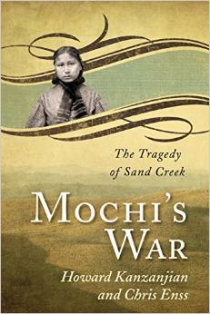Advance praise for Mochi’s War:
“The authors have again collaborated to write Western history in an accurate yet accessible manner for mainstream readers…this biographical account provides a counterpoint to the many works that have mythologized such women as Pocahontas and Sacajawea.” – Library Journal ***starred review***
Select praise for other books by Chris Enss and Howard Kazanjian:
“Unbelievable…” – The New York Post (Death Row All-Stars)
“Bittersweet and engrossing…” – True West Magazine (The Cowboy and the Señorita)
MOCHI’S WAR: The Tragedy of Sand Creek
TwoDot, an imprint of Globe Pequot, is proud to announce the June 16, 2015 release of Mochi’s War: The Tragedy of Sand Creek, by Chris Enss and Howard Kazanjian (978-0-7627-6077-0, $16.95 trade paperback).
After the Sand Creek Massacre of 1864, one woman survived physically unharmed, but emotionally devastated by the destruction of her tribe and determined to avenge her dead relatives. Her story has rarely been told, and Mochi’s War is the first book to tell it in full.
On November 28, 1864, Colonel John Chivington and his militia attacked a Cheyenne Indian village in southeastern Colorado. Between 150 and 200 Cheyenne Indians were estimated killed, nearly all elderly men, women, and children. The events at Sand Creek motivated Mochi to embark a decade long reign of terror. With each raid she remembered the horror of the massacre, and it goaded her on to terrible violence against those encroaching on Indian soil. The war between the Indians and the government lasted ten years after the Sand Creek Massacre occurred. Mochi’s war ended with her arrest and imprisonment in 1874 – the only woman ever to be incarcerated by the United States as a prisoner of War.
Mochi’s War: The Tragedy of Sand Creek explores the story and its repercussions into the last part of the nineteenth century from the perspective of a Cheyenne woman whose determination swept her into some of the most dramatic and heartbreaking moments in the conflicts that grew through the west in the aftermath of Sand Creek.
A portion of the book’s proceeds will go to the Sand Creek Massacre National Historic Site.


